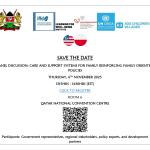Children Institutions
The State Department for Children Services (SDCS), through the Children Institutions Department plays a critical role in safeguarding and promoting the rights and welfare of children across Kenya. Over the years SDCS has established and operationalized the operation of 30 Statutory Children Institutions and overseen the operation 902 Charitable Children Institutions.
The 30 Statutory Children Institutions in Kenya, are government facilities that takes care of children who are in conflict with the law and those in need of care and protection. These institutions consist of;
14 Remand Homes: They are for the care, custody and protection of children in conflict with the law between ages 12 and 17 and whose cases are subsisting in the various courts in Kenya.
2 Reception and Classification Centers: They are for the reception, assessment and classification of children for purpose of placement to various rehabilitation schools based on the risk/needs level.
9 Rehabilitation Schools: They are for the care, custody, protection and rehabilitation of children found to be in conflict with the law and whose cases have been determined through a court process. They take care of children between ages 12 and 16.
5 Rescue Centers: They are for the care, custody and protection of children in need of care and protection.
The Mandate of Children Institutions Department
- Coordinate institutional child care and protection services.
- Design, coordinate, and monitor care, custody, rehabilitation, and reintegration programs for children in contact/conflict with the law.
- Support Care Reforms in both SCIs and CCIs on care, rehabilitation, tracing, reintegration, and transitioning to family/community-based care.
- Review and monitor implementation of Quality Standards in SCIs and CCIs.
- Coordinate with NCCS on renewal of registration of CCIs and child welfare programmes.
- Periodic review of placements in statutory and CCIs.
- Monitor the wellbeing of children in institutional care.
- Collate quarterly reports on children in both statutory and CCIs and share with relevant agencies.
- Supervise statutory and charitable children institutions (including routine inspections).
- Coordination of reintegration of children exiting institutions.
- Coordinate with development partners and stakeholders for child justice programmes.
Achievements
- Digitized operations in Statutory Children Institutions.
- Training Curriculum and Manual on Preventing and Countering Violent Extremism (PCVE) developed and 540 Children Officers trained.
- Developed and launched a training program on caring for children with disabilities and those with special needs.
- Improved Rehabilitation programs through;
- Empowerment initiatives
- Life Skills Training
- Training on Solar Technology
- Creation Support Structures
- Provision of Job-Readiness Programs
- Apprenticeship Placement



